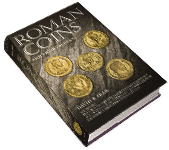 |
 
Millennium Edition (in five volumes)
by David R. Sear
Volume V: The Christian Empire: The Later Constantinian Dynasty and the Houses of Valentinian and Theodosius and Their Successors NEW
The fifth volume of the fully revised and expanded general catalogue of Roman coins concludes the coverage of the Imperial series from the joint accession of the three surviving sons of Constantine I in A.D. 337 down to the death of the Eastern Emperor Zeno a century and a half later. This period witnessed the consolidation of the role of Christianity as the new state religion and the final death throes of paganism. It also saw the catastrophic decline and final extinction of Roman power in the West, in the eight decades following the death of Theodosius I in A.D. 395; and the firm foundation of imperial power in the eastern Mediterranean region that was to last almost a thousand years, until the Turkish conquest of the remnants of the Byzantine Empire in 1453. The coinage of A.D. 337-491 underwent many changes in a bewildering succession of reforms, though Constantine's gold solidus remained the linchpin of the Imperial currency system and remained so into Byzantine times. Silver issues, plentiful in the 4th century, declined dramatically in the fifth, while the bronze coinage was ultimately reduced to the diminutive nummi, a situation that was remedied by the sweeping Anastasian reform of A.D. 498. The political complications of the 5th century, following the effective division of the Empire into eastern and western halves in A.D. 395, has led to difficulties in the classification of the coinage. Some of the standard sources focus on one of the parallel series (usually the eastern) to the exclusion of the other. In Volume V I have endeavored to simplify this for the collector by covering both series in one chronological sequence, thus emphasizing the unity of the Imperial series right down to the extinction of the western line of emperors in A.D. 476.
Price $85.00 plus $13.00 postage and handling in the U.S. or $25.00 for all foreign orders.

|


